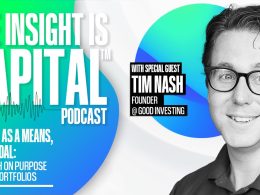by Hubert Marleau, Market Economist, Palos Management
April 5, 2025.
Last week, I wrote: “A reader reminded me that in 1912, J.P. Morgan said: ‘Gold is money, everything else is credit.’ This is a good reason to hedge portfolios with solid gold stocks. My concern is why the dollar has been acting badly of late. If it were just for cyclical reasons like the coming change in monetary stance, fiscal policy and growth differentials between the US and the rest of the world, there would be much to worry about. What is fearful is dollar selling by foreigners, whose the ownership of US assets are disproportionately huge. Foreigners own 18% of the US equity market versus 7% in 2000. February data on capital flow does not support that takeaway. According to Michael Howell of CrossBorder Capital, there is no evidence that money is leaving the US en masse. Nonetheless, foreign retaliation could take the form of asset sales. This must be avoided at all costs. In this connection, two things are needed to bring some confidence back: a reversal of sorts on tariffs or a compliant Fed.”
Trump said that he was not looking at the market, while Powell said that he was not about to offer imminent relief. This is pure nonsense. Everyone looks at the market. Unless some reprieve by either party on the monetary and tariff fronts emerge, the economy will sadly fall into a self-inflicted recession. Someone in the White House will then capitulate on a whim as pressure mounts from industry, pointing to the ultimate tariff rate, supply chains and spending plans; and from consumers, pointing to prices, quality and supply of goods. Elon Musk himself did, picking a fight with Peter Navarro, while elsewhere, veteran money managers, hedge-fund operators, venture capital entrepreneurs, private equity players, and CEOs all joined the chorus of dissenting voices, including an array of Republican senators.
This is why I believe the US will only keep the 10% tariff rate permanently for all goods entering the U.S. as payment for global military protection, while reciprocal tariffs and specific tariffs will be amended through negotiation. I also believe that the USMCA trade agreement will stay intact for good measure, but that high tariff rates on Chinese goods will remain - perhaps 50%. That's how I think things will develop in order to avoid a catastrophe. Acknowledging the individuality of reciprocal tariffs would lead to a long series of laborious bilateral negotiations with hundreds of countries, which would complicate hopes for a quick recovery, Wall Street reacted with unprecedented anger. Jamie Dimon, CEO of JPMorgan, and Bill Ackman. CEO of Pershing Square, warned of consideration turbulence if a quick resolution to tariffs fails; the US Chamber of Commerce has manifested its opposition to tariffs; the Association of Independent Businesses expressed its disfavour with Trump’s trade policy; and the vicious unwinding of US Treasuries created a liquidity crunch in the capital-constrained broker-dealer network. In a matter of just a few days the DXY fell 5.0%, yields on the 10-year Treasuries rose almost 100 bps and the S&P 500 tumbled 13.5%, forcing a tune change on tariffs from “Rock to Torch”.
What is particularly alarming is the steep rise in yields for long-term Treasuries. As a rule, Treasury yields fall when stock prices fall. I’m struggling with the idea that it has to do only with too much inflation fears and too much debt. There is a lot more to this strange vicious unwinding of Treasuries than meets the eye. There are 3 possibilities: 1) The trade dispute will end well and the economy will avoid a recession; 2) China might be dumping its holdings of Treasuries, converting the proceeds in Yuan; and 3) capital-constrained broker-dealers might not be unable to provide the liquidity to the secondary market for Treasuries. Any one of these reasons goes directly against Bessent’s wishes for lower bond yields.
So What Went On Last Week?
On Monday, there were no signs the US Administration was about to back down on tariffs, crushing all hope that it might intervene with a 90-day pause to stop the bloodpath and pushing the fear gauge to crisis level, thereby punching the S&P 500 bear-market ticket. The stock market went manically and mechanically crazy, Yardeni providing a precise narrative on what happened: “After the stock market crashed on Thursday and Friday of last week, we have to conclude that any day during which the Dow Jones Industrial Average isn’t down more than 1000 points is a good day. Today was an OK day. The DJIA plunged 1652.81 through 9:42 a.m. It then soared to 2518.86 by 10:16 a.m. on a bogus report that President Trump was willing to postpone tariffs by 90 days. By the end of the day, the DJIA was down 349.26”. The S&P 500 closed down only 0.2%.
On Tuesday, Bessent said the Trump Administration was open to negotiating with whomever to reduce tariffs, claiming willingness to offer good deals. Indeed it was reported that discussion had already started with Japan, Israel and others. Starting like a roaring lion, the stock market faltered when Trump said that he would follow through on his threat to impose an additional 50% tariff on China, bringing the total levy to 104% after China refused to cave. An early-day enthusiastic stock rally gave way to a major selloff toward the close because the cost of obliterating the commercial link with China is immense, effectively fencing themselves off from each other. The S&P 500 fell 1.6%, on the brink of a self-inflicted bear market.
On Wednesday, after the last round of tariffs kicked in, the Administration said that it was ready to talk with those countries who wished to make concessions. Later in the day, Trump delayed tariffs above 10% on most countries for a 90-day pause on tariffs on non-retaliating countries, announcing that more than 75 countries had called the White House to renegotiate and were not about to retaliate in any way, shape or form. The market loved it, and so did Goldman Sachs, who threw out its previous prediction that the economy would definitely fall into a recession. Traders covered their short positions, generating a historical rally and the S&P 500 soared 9.5%.
On Thursday, the market received a good piece of news on inflation and employment. Notably, inflation was cooler while employment was stronger than expected. Consumer prices decreased 0.1% m/m in March, registering a y/y increase of 2.4%, a big pullback form the 2.8% reported in February. Prices, excluding food and energy categories - the so-called core measure that captures the underlying inflation trends - rose 2.8%, below the 3% consensus forecast. Meanwhile, first-time unemployment benefits claims nudged up to 223,000, well below worrisome levels, while continuing claims fell 53,000. But although the probability of a recession, which had peaked at 70% last Tuesday, eased to 55%, it wasn’t enough to keep Wednesday’s record gain. Yes, the “volte face” removed the possibility of a true washout, but the uncertainty has not completely disappeared. Indeed, clarity was still missing from the equation. Thus the downside risks are still lurking. The trade war has narrowed but deepened. Amid an escalation of tariffs on China, which raised the U.S. effective tariff rate higher than it was before Trump flinched, the S&P 500 dropped 3.5% to 5268.
On Friday, US stocks neglected the University of Michigan reported that consumer sentiment darkened in April as the index fell to 50.8 in April to a 3-year low. Instead, they got a nice boost, enjoying the March reading on wholesale prices. Headline PPI decreased 0.4%, the first drop in 17 months, bridging the 12-month change down to 2.7%. The S&P 500 rose 1.8%, closing at 5363.
Believe it or not, we just had the best week of the year for stocks.
The Conclusion
Did the S&P 500 touch bottom at 4983 and will it go back to its former high (6144)? Technically yes, but it’s fundamentally questionable. I’ve reviewed my earlier 2025 forecast for the S&P 500, reducing my target to 6150 from 6650, and think it will get there slowly and in a choppy fashion. Yardeni, however, is targeting 6000, with a 55% chance that the Roaring 2020s scenario will resume.
On the one hand, the technicals are consistent with past corrections and sentiment expressed by the AAII Bull/Bear Ratio, the VIX, and the CNN Fear and Greed Index, which are so depressed that from a contrarian perspective, all the readings are bullish. In this connection, investors should expect many buyback announcements. MSFT and AVGO have already said that they are in for $10 billion each.
On the other hand, fundamentals are up in the air because they are dependent on whether we are going to end with a vicious recession or not, which could create a serious earnings risk. Trump’s dramatic U-turn has isolated China as the primary target of his trade offensive. This will keep energy and mineral prices lower, which has usually in the past promoted a higher level of economic activity, than it ought to be for a while longer, until the full effect of the new Chinese monetary and fiscal stimulus on domestic demand expansion will eventually set in.
What is important is that the so-called tail risk - the result of unpredictable and extreme events - has thinned out because the unknowns are known. In other words, the peak of the trade war may have passed. We now know that the Trump administration is willing to temper its stance to equity, exchange and bond market turbulence, indicating sensitivity to market stress. Indeed, declines of the magnitude that we have just seen are rare. The VIX, a key measure of volatility, has been over 40 for the last 5 trading days; and from a contrarian point of view, this is very bullish, predicting with 95% accuracy that the S & P 500 could pop up 30% over the next 12 months. In fact, widespread selling by algorithm-oriented traders is usually not an effective strategy for investors to emulate. The shake-out may have ended because it has by now absorbed the full brunt of the massive shock.
Copyright © Palos Management















